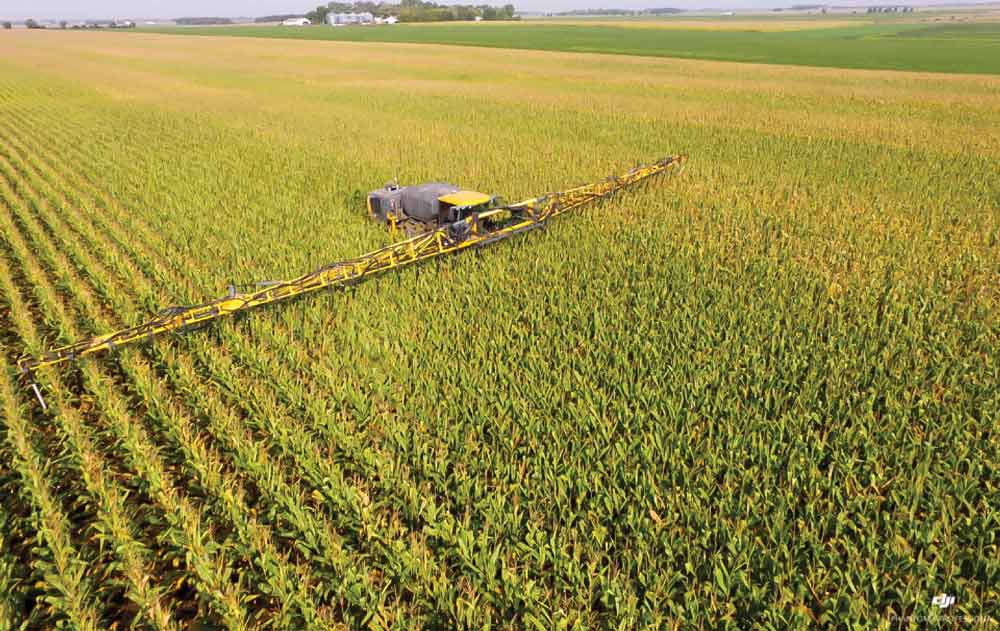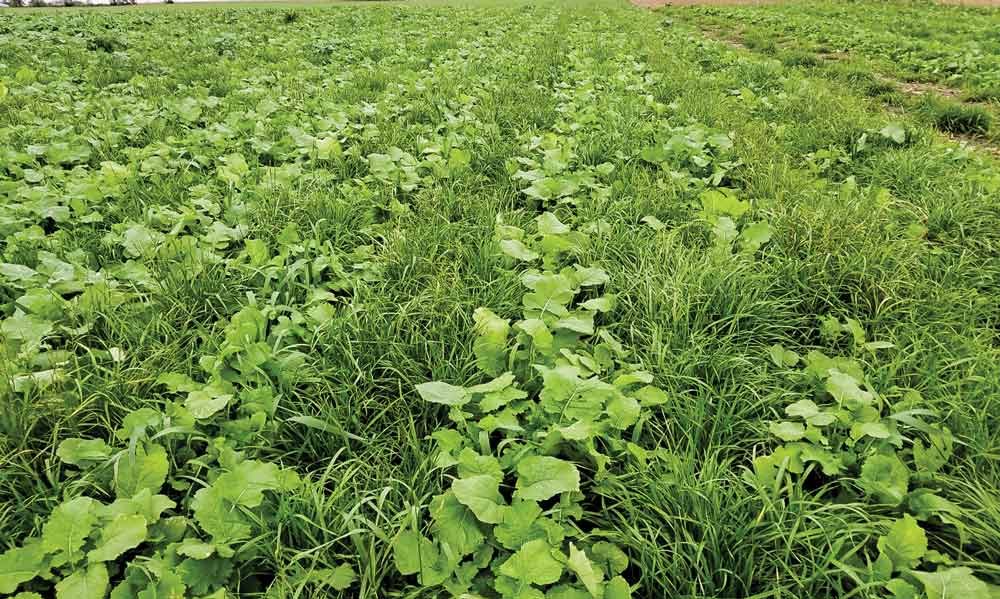Pictured Above: DECISION FACTORS. Tom Cotter’s guidelines for cover crop mixes include his goals, the history of that field, future plans for a specific field, soil type, climate, livestock, tillage practices, the seed provider and seed costs.
My family has been farming in southern Minnesota for 143 years. Great-grandpa began tilling the soil back then, and every generation since has done the same thing.
Farming is like playing chess. When I was doing everything the conventional way, farming was like checkers. One easy move at a time. Now that I’m in the cover crop world and no-till, it’s like chess. I have to think one, two or three moves or years ahead. I also think about what I did 2 years ago.
Each year, I pick out my practice, situation, cover, cash crop and future plans for each field. It’s always changing. I like to have options and see what’s working the best for each year.
Each Year is Different
With cover crops I often feel farmers are holding themselves back. Everyone is doing the exact same thing as their grandpas did, even though times have changed. I say don’t use cover crops and no-till because everyone else is doing it. Do it because you believe in it. When you’re doing covers, you learn to adapt and change very fast.
3 Takeaways
- Have a long-term plan for each field. Knowing its history and planting intentions for future years will help with decision making.
- In heavy soil, grass covers do better. In light soil, brassica covers do a good job.
- Have guidelines to help with selecting cover crop varieties, such as annual weather conditions, objectives, livestock, tillage practices, seed provider and cost.
Do we have to change what we plant and make it fit our climate? Absolutely. I look at temperature highs and lows. I can get things to overwinter pretty easily because my snow protects my covers, and my covers protect my soil. The soil protects my underground “livestock,” which is soil microbes and worms.
You have to be very flexible when implementing covers. Here are a few things I assess when choosing what type of covers to plant.
- Check the soils. Are they heavy or light? Is it balanced? On my farm, if I’ve got really heavy soil, grasses are pretty dominant there. In really light soil, brassicas take off and do a really good job.
- How much moisture do you get in a season? That determines what kind of cover crops I plant on my farm. If it’s really dry, I’m not going to use something that prefers wet conditions.
- Have guidelines. For choosing cover crop mixes, I look at my goals, the history of that field and what I have planned for it in the future. I also look at the soil type, climate, livestock, tillage practices, the seed provider and the costs.
- What have you been doing for the last 10 years? For the last 40 years? It makes a difference. What is the future of your farm, cash crops and farming techniques? I can’t say there’s only one way to do something because it’s your farm. You need to learn for yourself.
- Diversity is a must. I have grass-fed cattle. Too many people think cover crops are this one dirty plant that’s going to fill in the time that you’re not having your cash crop. It can also be a cash crop. In my experience, if you do a good job with cover crops, you’ll see weed suppression right away, in year one.
- Water infiltration is another huge benefit for me. My cover crops and no-till practices have helped my drainage even without tile in spots. That’s the whole principle with covers and no-till or strip-till.
- Get those cover crop roots established. When corn shades everything out, you need to have a root system in place that that plant can survive on. I don’t worry about top growth.
- For me, annual ryegrass is the staple program. I love vetch, red clover and some brassicas like bayou kale. I have done cow peas, Austrian winter peas and lots of other varieties. I have a little harder time with crimson clover in that scenario.
- Look at the stature of the corn. If I pick a variety that’s going to get 14 feet tall, interseeding is going to be pretty tough. I also look at how upright the leaves are. I even look at east/west and north/south rows. If I’m interseeding into corn at the V6 stage, I like them east/west. If I’m planting later in the year, I like seeding them north/south. That’s just the way I see the sunlight hitting the ground.
- Consider government programs. If you are enrolled, use that money to the max for a goal. I use my payments for covers. I wanted to give my soil this big energy drink and then maintain it with other covers. I kept using it as a jump-start for multi-species covers — a 17-way or 12-way mix. In 2019, it was a 31-way mix.
Get the cover crop going first before hauling manure. That one week or however long you wait, you’re going to be that much farther behind on heat units.
Know Your Seed Provider
It’s important to know your seed provider. Do you have your own seed that you raised? Sometimes it turns out good, sometimes not. Make sure you get it germ tested.
Be very careful when selling seed to a neighbor. It can wreck a friendship and get you into trouble.

USE ALL THE SENSES. Austin, Minn., farmer Tom Cotter assesses soil health by examining soil structure, earthworm populations and the sound of roots tearing when pulled. In winter, he checks on cover-cropped areas under the snow to make sure the soil is still pliable.
Don’t just buy your seed from anywhere or anyone. Ask tried-and-true seed providers how they produce their seed. I had a chance to go to Oregon and see where they grow the world’s grass. I was just amazed at how those fields were made. They were tilled just like concrete.
There are other companies out there that do no-till and livestock grazing. Make sure you check to get seed that is grown in a way that is the same that you’re doing on your operation. You get what you pay for. If you find a good deal, there’s probably a reason for it.
Build a relationship with your seed provider. The first time I did no-till into cover crops I pulled out my phone many times to call my seed provider. I had so many questions. But even if you’re scared about establishing cover crops, you can make it work.
“When I pull up a root, if I hear that tear, I know there is good soil health…” – Tom Cotter
Cheaper is not always better. When I seed, I really don’t look at pounds. I look at seeds per square foot. I usually have 2-3 varieties anytime I seed, even if it’s V6 interseeding. I want that diversity.
I do look at current weather patterns. If it’s dry, I’m going to plant differently. If it’s really dry, I’m going to get that seed in the ground and also change some varieties. If there’s plenty of moisture, I’ll spread the seed on top and not do any tillage.
Interseeding Brings Choices
V6 interseeding in early summer works great because it gives me more opportunity to get diversity of cover crop species in there. When you interseed, you get choices. I get to plant nearly half a dozen more species that way that I probably wouldn’t be able to use in fall. That’s important. If I’m not grazing, I lighten it up, but if it’s going to be grazed, I plant it heavier.
In mid-summer or early fall, you can broadcast the seed on top if there’s a lot of moisture. If there’s not, you better drill it. After harvest, get it in the ground. To me, that’s No. 1 — I want to get things established as soon as possible.
If need be, hand broadcast and just go throw some seeds out there. If you haven’t planted anything, at least throw something out there so you can see what the plant looks like. I guarantee you, when a bunch of plants are out there, they’re not going to look the same. If you plant something and see what it looks like, you’ll be miles ahead.

INTERSEEDING CHECKS. Minnesota grower Tom Cotter looks at corn height before interseeding, as well as how upright the leaves are on the corn plants. If he interseeds at the V6 stage, he plants the covers in an east/west configuration. Planting covers later in the year is done in a north/south configuration to maximize the amount of sunlight hitting the covers.
I always try to frost seed. I look around the farm and see all my bare spots from wintertime when it freezes and thaws and water sits and chokes out my covers. I spread something on that spot. I don’t want to have bare soil. I just want to make sure I have more coverage.
Get Creative with Grazing
I have grazing opportunities. It’s amazing what livestock can do. When I started doing covers, I didn’t bring the livestock into the operation. I didn’t know what I was doing 20 years ago. Now, I love putting cattle out to graze.
Sometimes you have to get creative. In 2018, I had my grazing plan all set out but realized I wasn’t going to get to one paddock before the weather changed. So, I harvested that paddock as forage.
“If you do a good job with cover crops, you’ll see weed suppression in year one…” – Tom Cotter
When I first started, my costs were $6 per acre. That’s how much I could buy cereal rye for per bag. Now prices are up, and with cattle they’re even higher. After I’ve harvested canning crops, I am fine with higher cover crop seed prices because I know I can utilize those covers much better. So, I go up to $46 per acre. Most times, you’re going to average right in that $18-$35 range.
Gauging Results
Cover crops play an invaluable role in improving soil health, and it’s important for farmers to take assessments of any improvements.
Growers know their land better than anyone and should use all five senses when assessing soil health. When I walk out in my field, I can feel myself sink in the ground. I can see and feel the soil structure. I can see worms.
When I pull up a root, if I hear that tear, I know there is good soil health. I go out in the winter and dig under the snow to pull up my cover crop to check on the soil. It’s still pliable.
It’s important to ensure the land is healthy and do your best to take care of it.






Post a comment
Report Abusive Comment